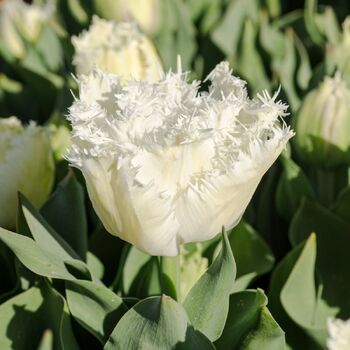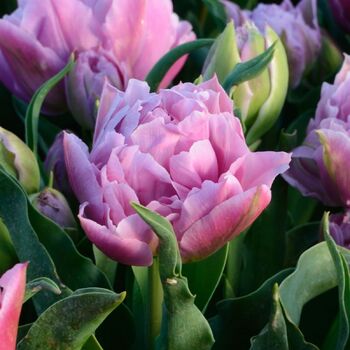
How to Grow Tulip Bulbs
Grow Guide #2378
Family: Liliaceae
Binomial name: Tulipa hybrida
Life Cycle: Perennial
This 'How to Grow' guide details everything a home gardener needs to know to plant, grow and care for Tulips (Tulipa hybrida).
When to Plant Tulip Bulbs
Use the table below to identify the best time of year to plant tulip bulbs in your climate.
| JAN | FEB | MAR | APR | MAY | JUN | JUL | AUG | SEP | OCT | NOV | DEC | |
|---|---|---|---|---|---|---|---|---|---|---|---|---|
| Cool | ||||||||||||
| Temperate | ||||||||||||
| Sub-Tropical | ||||||||||||
| Tropical | ||||||||||||
| Arid |
Preparation
Tulip plants are best grown in full sun or part shade. Choose a location that will receive at least 3 hours of full sun each day.
Tulip plants need a loose, well drained soil enriched with organic matter. Prepare soil by weeding it thoroughly, digging it over to at least a spade’s depth to loosen the soil, and adding aged animal manure or compost. Organic matter can be dug into heavy soil to lighten it so roots can grow freely. Keep the area free of weeds until planting. Learn more about preparing soil for planting here.
Tulip plants can be grown in containers. If possible choose a variety that’s recommended for container growing. Use a good quality potting mix and make sure your container is large enough for mature plants; a minimum of 10 litres is recommended for tulips. During the growing season, keep in mind that container grown plants may need additional fertiliser to encourage healthy growth.
How to Plant Tulip Bulbs
Tulip is a cold climate bulb that needs a period of cold temperature in winter to flower. In areas that do not get regular frosts, tulip bulbs can be chilled in the refrigerator to simulate a cold winter. Place bulbs in an open paper bag in the fridge, away from ripe fruit and vegetables, for 6-8 weeks prior to planting them.
Tulip bulbs should be planted directly in their final position in the garden or a container.
- Plant individual bulbs 20cm apart and 15-20cm deep with the pointed tip facing upwards.
- Cover with soil and water in well.
- Keep soil moist but not wet until shoots emerge.
How to Grow Tulips
Tulip plants may need watering during the growing season. Water when the soil is dry about 5cm below the surface (test this by scratching away a little soil with your finger). Water deeply in the early morning or late afternoon. Avoid watering the leaves of plants to avoid fungal diseases. Learn more about watering here.
If soil was well prepared no extra fertiliser should be necessary, as bulbs store all the energy needed to bloom from the previous year's growth. In poor soil or to give your plants an extra boost, application of a high-potassium fertiliser or one formulated for flowering plants can be beneficial:
- apply slow release fertiliser at the recommended rate when the first shoots emerge, OR
- apply liquid fertiliser at the recommended rate and frequency when the first shoots emerge.
After flowering, fertilise bulbs with blood and bone or aged or pelletised chicken manure and water in well.
Tulip plants should flower in approximately 60-90 days.
Deadhead or cut tulip flowers regularly during the growing season. Using sharp secateurs or snips, cut flowers for picking with the longest stems possible, or snap off dead flowers. Removing old flowers regularly will direct the plant's energy back into the bulb rather than into the production of seeds.
Leave foliage to die down naturally after flowering; the bulb will absorb the nutrients in the leaves and use them to form the flowers for next season. Once all foliage has died down use sharp secateurs or snips to cut individual leaves at ground level.
Bulbs grown in containers and in warm climates are generally treated as annuals and discarded after flowering. In cool but frost-free climates bulbs need to be lifted and chilled prior to replanting to ensure repeat flowering. In cold climates with regular frosts bulbs can be left in the ground to naturalise and lifted to move them or when they are overcrowded.
To lift tulip bulbs, use a garden fork to lift the bulbs from the soil, taking care not to damage them. Prune off any dead leaves still attached to the bulb. Store bulbs in a cool, dry space on a wire rack or in a bag that allows good airflow, such as one made from netting. Temperatures around 20 degrees are ideal for storage; exposure to hot temperatures (over 30 degrees) may affect the viability of the bulbs. Bulbs can be replanted the following season in line with the planting chart above.
Common Problems when Growing Tulips
Like all plants, tulip is susceptible to some pests, diseases and other problems. Below is a list of the most common problems gardeners encounter when growing tulip plants:
 Aphids are small (2-4mm long) sap-sucking insects that congregate on the new shoots or the undersides of leaves. They can cause leaves to wilt or become discoloured, and also excrete honeydew which can attract ants and other insect pests. To manage aphids, remove them by spraying with a garden hose, apply a soap or alcohol spray, or encourage predatory insects to your garden. Read more about aphids here.
Aphids are small (2-4mm long) sap-sucking insects that congregate on the new shoots or the undersides of leaves. They can cause leaves to wilt or become discoloured, and also excrete honeydew which can attract ants and other insect pests. To manage aphids, remove them by spraying with a garden hose, apply a soap or alcohol spray, or encourage predatory insects to your garden. Read more about aphids here. Grey mould (Botrytis sp.) is a fungal disease that causes flowers to become mouldy and fruit to rot. Spores are transported by wind and can survive in soil or on green waste. The fungus spreads most in cool, damp weather. Prune off affected flowers and fruit, water plants at soil level (not on leaves) and if necessary spray with an appropriate fungicide or homemade spray.
Grey mould (Botrytis sp.) is a fungal disease that causes flowers to become mouldy and fruit to rot. Spores are transported by wind and can survive in soil or on green waste. The fungus spreads most in cool, damp weather. Prune off affected flowers and fruit, water plants at soil level (not on leaves) and if necessary spray with an appropriate fungicide or homemade spray..jpg) Rotten bulbs or corms are caused by pathogens entering bulbs or corms after sitting in cold, wet soil, being temporarily waterlogged or being exposed to warm temperatures in winter. They may show obvious signs of rot, have no roots or shoots, or produce stunted yellow leaves but no flowers. Plant bulbs and corms in free-draining soil, raised garden beds or containers; do not water while dormant; and lift and store them if recommended for your climate.
Rotten bulbs or corms are caused by pathogens entering bulbs or corms after sitting in cold, wet soil, being temporarily waterlogged or being exposed to warm temperatures in winter. They may show obvious signs of rot, have no roots or shoots, or produce stunted yellow leaves but no flowers. Plant bulbs and corms in free-draining soil, raised garden beds or containers; do not water while dormant; and lift and store them if recommended for your climate. Slugs and snails are molluscs that feed on tender leaves and shoots, mostly at night, leaving slimy trails behind them. Control them by removing their hiding places, keeping free range poultry, collecting them by torchlight or by placing traps. Read more about slugs and snails here.
Slugs and snails are molluscs that feed on tender leaves and shoots, mostly at night, leaving slimy trails behind them. Control them by removing their hiding places, keeping free range poultry, collecting them by torchlight or by placing traps. Read more about slugs and snails here. Thrips are black, beige or white flying insects (<1.5mm) with larvae that suck tissue from leaves and petals, leaving behind very small white or transparent markings. While not usually causing serious damage, the marks affect the look of flowers and foliage and thrips can also transfer pathogens from one plant to another. Wash thrips from affected plants using a garden hose, encourage predatory mites and lacewings with companion planting, or spray with soap, eco-oil or neem oil.
Thrips are black, beige or white flying insects (<1.5mm) with larvae that suck tissue from leaves and petals, leaving behind very small white or transparent markings. While not usually causing serious damage, the marks affect the look of flowers and foliage and thrips can also transfer pathogens from one plant to another. Wash thrips from affected plants using a garden hose, encourage predatory mites and lacewings with companion planting, or spray with soap, eco-oil or neem oil.


.png)






